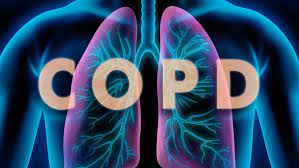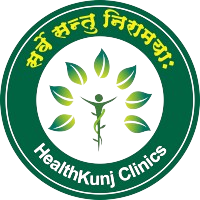COPD (Chronic Obstructive Pulmonary Disease) -
Symptoms, Causes, Prevention & Homeopathic treatment

Overview
Chronic Obstructive Pulmonary Disease (COPD) is a progressive lung disease characterized by persistent airflow limitation that is not fully reversible. It includes conditions such as chronic bronchitis and emphysema, which cause breathing difficulties due to inflammation and damage to the airways and lung tissue. COPD primarily affects adults and is a leading cause of morbidity and mortality worldwide.
Symptoms
The symptoms of COPD typically develop gradually and may include:
- Chronic Cough: A persistent cough that often produces mucus (sputum). This is particularly common in chronic bronchitis.
- Shortness of Breath: Difficulty breathing, especially during physical activity or exertion.
- Wheezing: A high-pitched whistling sound when breathing, particularly during exhalation.
- Chest Tightness: A feeling of constriction or pressure in the chest.
- Increased Mucus Production: Excess mucus in the airways, which may lead to frequent coughing.
- Fatigue: Generalized tiredness and reduced energy levels due to the body’s effort to breathe.
When to See a Doctor
Consult a healthcare provider if:
- Persistent Symptoms: Symptoms such as chronic cough, shortness of breath, or wheezing persist over time or worsen.
- Severe Breathing Difficulty: Significant or worsening shortness of breath, particularly if it interferes with daily activities.
- Frequent Respiratory Infections: Frequent exacerbations or respiratory infections that do not improve with treatment.
- Symptoms of Complications: Signs of complications such as chest pain, swelling in the ankles, or sudden weight loss.
- Change in Condition: Noticeable changes in the severity or nature of symptoms, or if current treatments are no longer effective.
Causes
COPD is primarily caused by long-term exposure to harmful substances that damage the lungs and airways:
- Smoking: The leading cause of COPD, with cigarette smoke containing numerous harmful chemicals that irritate and damage the respiratory system.
- Air Pollution: Exposure to outdoor air pollution, such as vehicle exhaust and industrial emissions, can contribute to the development of COPD.
- Occupational Hazards: Long-term exposure to dust, fumes, and chemicals in the workplace can increase the risk of COPD.
- Genetic Factors: Genetic predispositions, such as alpha-1 antitrypsin deficiency, can contribute to the development of COPD, although this is less common.
- Environmental Factors: Exposure to indoor air pollutants, such as secondhand smoke and biomass fuel smoke, can exacerbate the condition.
Risk Factors
Several factors can increase the risk of developing COPD:
- Age: COPD is more common in older adults, as lung function naturally declines with age.
- Gender: Historically, COPD has been more common in men due to higher smoking rates, but the gap is closing as smoking rates among women increase.
- Family History: A family history of COPD or other respiratory conditions can increase susceptibility.
- Socioeconomic Status: Lower socioeconomic status may be associated with increased exposure to risk factors and reduced access to healthcare.
- Pre-existing Respiratory Conditions: Conditions such as asthma or chronic bronchitis may increase the risk of developing COPD.
Complications
If not properly managed, COPD can lead to several complications:
- Respiratory Infections: Increased susceptibility to infections such as pneumonia and bronchitis.
- Heart Problems: COPD can strain the heart and lead to conditions such as right-sided heart failure (cor pulmonale).
- Lung Cancer: Long-term smoking and COPD are associated with an increased risk of lung cancer.
- Pulmonary Hypertension: High blood pressure in the pulmonary arteries can develop as a result of chronic lung disease.
- Osteoporosis: COPD and its treatments can lead to decreased bone density and increased fracture risk.
Preventions
Preventive measures can help reduce the risk of COPD or slow its progression:
- Avoid Smoking: Do not smoke and avoid exposure to secondhand smoke and other tobacco products.
- Minimize Exposure to Pollutants: Reduce exposure to air pollutants and occupational hazards by using protective equipment and improving indoor air quality.
- Vaccinations: Get vaccinated against influenza and pneumonia to reduce the risk of respiratory infections.
- Regular Exercise: Engage in regular physical activity to maintain overall health and improve lung function.
- Healthy Diet: Maintain a balanced diet to support immune health and overall well-being.
- Avoid Allergens: Minimize exposure to allergens and irritants that can trigger respiratory symptoms.
Can Homeopathy Help?
Homeopathy can provide supportive care for individuals with COPD by addressing symptoms and improving overall well-being.
A homeopathic practitioner will assess the patient’s specific symptoms and overall health to choose the most appropriate remedies.
Diagnosis
Diagnosing COPD involves several key steps:
- Medical History: Review of symptoms, smoking history, and exposure to environmental or occupational irritants.
- Physical Examination: Examination of the chest and lungs to assess breathing patterns, wheezing, and use of accessory muscles.
- Spirometry: A lung function test that measures airflow and identifies any obstruction in the airways.
- Chest X-ray: Imaging to rule out other conditions and assess the extent of lung damage.
- CT Scan: A detailed imaging test that provides a more precise view of lung structure and can help identify emphysema.
- Arterial Blood Gas Test: Measures oxygen and carbon dioxide levels in the blood to assess lung function.
Treatments
COPD management typically involves a combination of medications, lifestyle changes, and supportive therapies.
Lifestyle and Home Remedies
Incorporate these lifestyle changes and remedies to support COPD management:
- Quit Smoking: If you smoke, seek help to quit smoking and avoid exposure to secondhand smoke.
- Healthy Diet: Follow a balanced diet to maintain a healthy weight and support overall health.
- Regular Exercise: Engage in physical activity to improve lung function and overall fitness.
- Breathing Techniques: Practice pursed-lip breathing and diaphragmatic breathing to improve oxygen intake and manage symptoms.
- Hydration: Drink plenty of fluids to keep mucus thin and manageable.
- Avoid Irritants: Minimize exposure to allergens, pollutants, and irritants that can exacerbate symptoms.
Preparing for Your Appointment
To make the most of your appointment, consider the following:
- Symptom Journal: Keep a detailed record of your symptoms, including their frequency, severity, and any potential triggers.
- Medical History: Provide a thorough history of your health, including smoking history, exposure to irritants, and any previous respiratory conditions.
- Medication List: Bring a list of all current medications, including dosages and frequency.
- Questions: Prepare a list of questions about your diagnosis, treatment options, and lifestyle modifications.
- Support System: Involve family members or caregivers to discuss care strategies and provide support.
